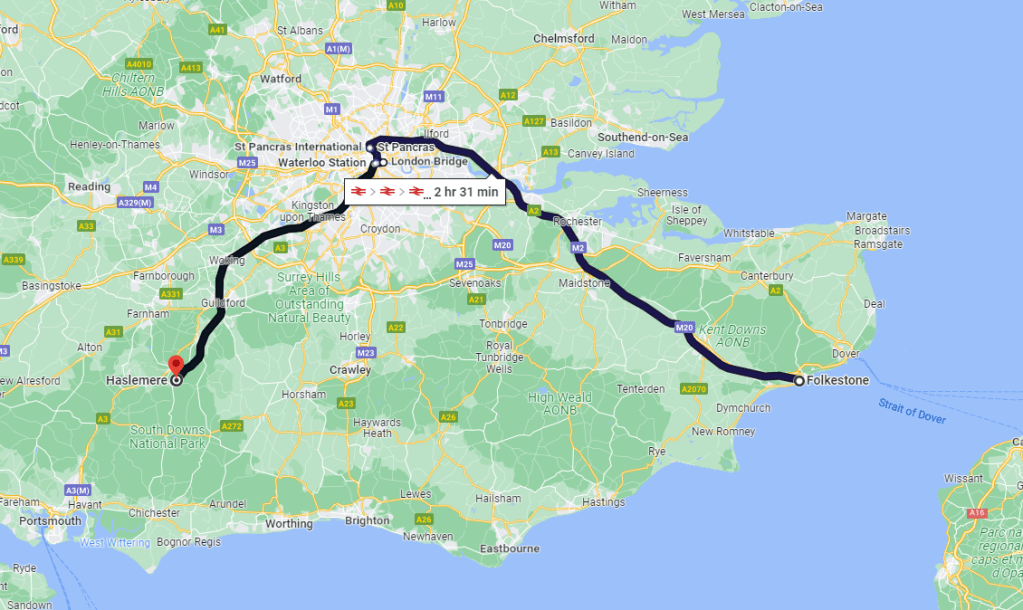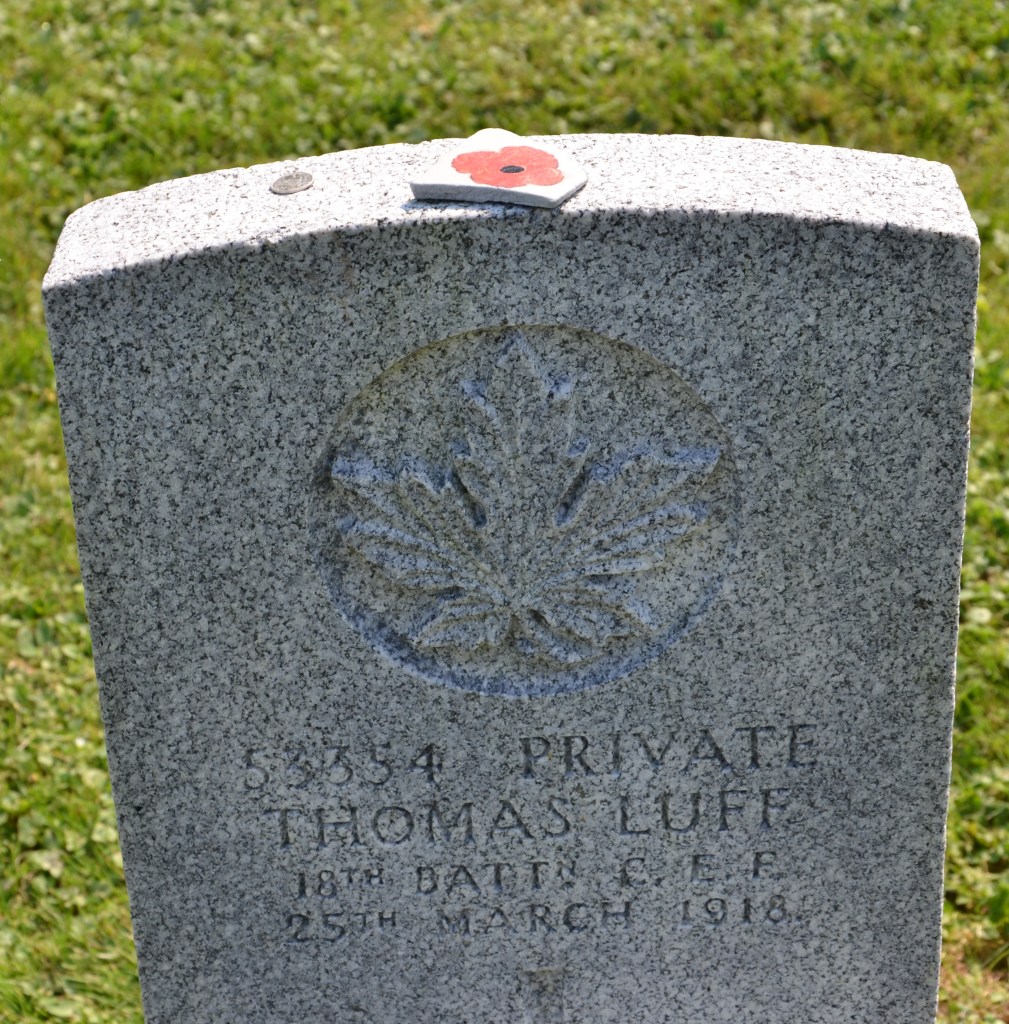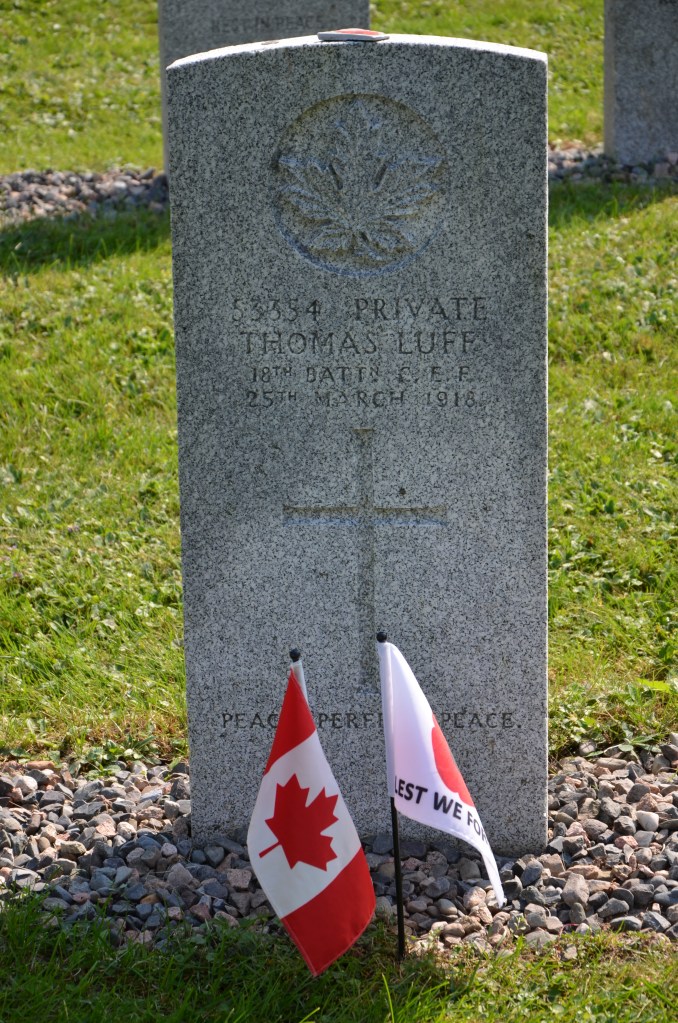The third in a series of posts exploring men of the 18th Battalion who were buried in the Canadian Maritimes. The author visited the grave of this soldier to acknowledge his service to our nation and to let him know he is not forgotten.
This is only part of his story.
Private Thomas Luff’s story is a more a mystery than the previous two posts. His service records do not paint as full a picture of the other men in this series so far but from what research that was found one can derive a portion of his life from time of his enlistment to the end of his service.
Thomas Luff was born a Haslemere, Surrey, England and he reported that his date of birth was 1 June 1870 making him 44 years and 5 months old, just at the edge of the maximum age of enlistment for a recruit of the Canadian Expeditionary Force (CEF) at the time. He reported his trade or calling as a labourer and hew was unmarried at the time of enlistment. He claimed 13-years of service with the “Leicester Regiment”.
With a regimental number of 53354, the now Private Luff was an original member of the 18th Battalion and he enlisted where it was based during the Fall of 1914 and the Winter of 1915 – London, Ontario. His service card shows no demerits during the training phase the 18th Battalion experienced and he was with the 18th when it embarked for England for the next stage of its training at West Sandling Camp near Folkestone, England, arriving there on 29 April 1915.
A week barely passed and Private Luff is recorded to have been docked one-day’s pay for being Absent Without Leave (AWL). With Private Luff being in so close proximity to family and friends the temptation to go AWL was high, and it was not at all uncommon for the men of the 18th and other 2nd Contingent battalions and units stationed in England to take “advantage” of this proximity to skip out and visit their loved ones. This was so common and accepted that there is no mention of this issue in the 18th Battalion War Diaries during its time at West Sanding from May to September 1915.

Sadly, Private Luff’s age was probably showing, as on 8 August 1915 he was Struck Off Strength (SOS) from the 18th Battalion and Taken On Strength (TOS) with the Canadian Army Corps Depot Company. By 5 September 1915 he was transferred to the Canadian Convalescent Hospital at, what appears to be, Heston.




From there his service record makes it difficult to interpret his movements but it is clear that he has been moved several times for treatment and then his records firm up showing him being assessed on 2 July 1916 suffering from varicose veins in the left foot which have been increasing is size and creating cysts that had to be treated. This condition led him to be classed on 4 July 1916 at the Ontario Military Hospital, Folkestone, as Permanent Base Duty (PBD) only as a Medical Board found that he had a left flat foot and swollen ankle.
One possible compensation for what would be a disappointing outcome for a man eager to serve was that Private Luff became a husband. Beginning in July 1916 he assigned $20.00 per month to his new wife, Ellen, residing at Camels Dale, Haslmere.
On 27 January 1918 a Medical Board was convened and due to the following:
“DISABILITY
“Ganglion on outer side of left ankle.”
Present Condition”
This I have now burst. It will probably re-appear. He is over-age but an old soldier and appears a good type of man.”
The Board determined he was fit for Permanent Light Duty
But he was later to classified at “Biii” and “not likely to be cured” on 5 February 1918. This may be an indication that Private Luff’s physical condition was declining.
On 23 February 1918 he had boarded a ship for Canada from Liverpool and it is recorded that while in transit on the HMT Grampian he began to suffer an oedema to the legs, indicating a possible cardio-vascular issue with his health.
The ship arrived at St. John, New Brunswick and Private Luff was transferred to the hospital at the “Armouries” with a possible case of Bright’s Disease on 9 March 1918 and he remained in the care of this facility until 25 March 1918 when it is recorded that he died of heart failure.


From the service record and this soldier’s medal card it is evident that his wife did not travel to Canada, and though Private Luff could have requested to be discharged in England, it appears that their plan was to have Mrs. Luff emigrate to Canada sometime after Private Luff’s return to Canada.
Private Luff is buried at Saint John (Fernhill) Cemetery in the Field of Honour at Grave no. 15. He rests with 102 other fallen from Canada and the Commonwealth. On the visit to his grave someone had left a small token on the to of the gravestone and it was oddly comforting to the author to see that someone else had come to his grave and presented tangible recognition to his service.

I think it can be said that the service experience that Private Luff experienced was not at all what he was hoping or expecting.
The important thing to note is he was willing to serve. Ironically, that service may have contributed to his death.
The Canadian Government sent his campaign medals, scroll, and plaque to his widow residing at Haslmere and a Memorial Cross was sent to his widowed mother, Mrs. Ruth Luff of Mill Cottage, Shottersmill, England.
We can take solace that his grave is well tended and he is in the company of other service personnel as he rests for the rest of eternity.
Lest We Forget.


Leave a comment